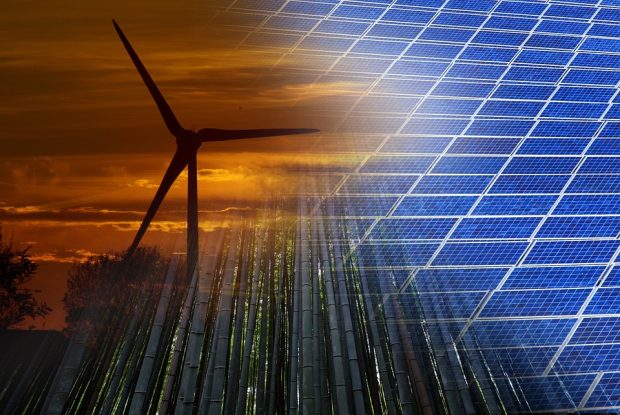
The latest issue of the U.S. Energy Information’s “Electric Power Monthly” (with data through April 30) reveals that—for the first time since the beginning of the nuclear era—renewable energy sources (i.e., biomass, geothermal, hydropower, solar—inc. small-scale PV, wind) are now providing a greater share of the nation’s electrical generation than nuclear power.
For the first third of this year, renewables and nuclear power have been running neck-in-neck with renewables providing 20.20 percent of U.S. net electrical generation during the four-month period (January to April) compared to 20.75 percent for nuclear power. But in March and April, renewables surpassed nuclear power and have taken a growing lead: 21.60 percent (renewables) vs. 20.34 percent (nuclear) in March, and 22.98 percent (renewables) vs. 19.19 percent (nuclear) in April.
While renewables and nuclear are each likely to continue to provide roughly one-fifth of the nation’s electricity generation in the near-term, the trend line clearly favors a rapidly expanding market share by renewables. Electrical output by renewables during the first third of 2017 compared to the same period in 2016 has increased by 12.1 percent whereas nuclear output has dropped by 2.9 percent. In fact, nuclear capacity has declined over the last four years, a trend which is projected to continue, regardless of planned new reactor startups.
From 2013-16, six reactors permanently ceased operation (Crystal River, Kewaunee, San Onofre-2, San Onofre-3, Vermont Yankee, Fort Calhoun), totaling 4,862 MW of generation capacity. Last year, one new reactor (Watts Bar-2) was connected to the grid (after a 43-year construction period), adding 1,150 MW, for a net decline of 3,712 MW since 2013. Six more reactors are scheduled to close by 2021, totaling 5,234 MW (5.2 percent of nuclear capacity). Two more reactors totaling 2,240 MW are scheduled to close by 2025.
In addition, nuclear generators are discussing the potential retirements of several more. Against the planned retirement of 7,274 MW of capacity, four new reactors are in construction, totaling 4,468 MW. The completion of these reactors is in doubt, however, due to billions of dollars in cost overruns and the bankruptcy of designer-builder Westinghouse.
If all reactors being built are ultimately completed, total nuclear generating capacity will decline by at least 2,806 MW (three percent) by 2025, planned additions against planned retirements. If these projects are cancelled, nuclear capacity will decline by at least 7,274 MW (7.2 percent) from 2017, accounting for roughly 57,000 TMWh/year of generation.
On the other hand, almost all renewable energy sources are experiencing strong growth rates. Comparing the first four months of 2017 to the same period in 2016, solar has grown by 37.9 percent, wind by 14.2 percent, hydropower by 9.5 percent, and geothermal by 5.3 percent. Biomass (inc. wood and wood-derived fuels) has remained essentially unchanged—slipping by just 0.3 percent.
In recent years, the strong growth rates of both solar and wind have resulted in new records being set virtually every month. For the second month in a row, solar and wind combined provided more than 10 percent of the nation’s electrical generation. In March 2017, those sources provided 10.04 percent of the nation’s electrical generation. That record was eclipsed in April when solar and wind reached nearly 11 percent (10.92 percent) of total generation. And, for the first time, wind and solar combined have provided more electricity year-to-date (113,971 thousand megawatt-hours (TMWh)) than has hydropower (111,750 TMWh).
In April, solar alone reached another milestone, providing more than two percent (2.33 percent) of the nation’s electrical supply. Consequently, solar has now moved into third place among renewable sources—behind hydropower and wind but ahead of biomass and geothermal. In April, utility-scale plus small-scale solar provided 20,928 TMWh compared to 20,509 TMWh from biomass and 5,945 TMWh from geothermal.
And not coincidentally, as renewables’ share of electrical generation has grown, that of fossil fuels has declined. Electrical generation by fossil fuels (i.e., coal, natural gas, petroleum liquids + petroleum coke) dropped by 5.2 percent during the first third of 2017 compared to 2016.
“In light of their growth rates in recent years, it was inevitable that renewable sources would eventually overtake nuclear power,” noted Ken Bossong, executive director of the SUN DAY Campaign. “The only real surprise is how soon that has happened—years before most analysts ever expected.”
“Renewable energy is now surpassing nuclear power, a major milestone in the transformation of the U.S. energy sector,” said Tim Judson, executive director of the Nuclear Information and Resource Service.
“This gulf will only widen over the next several years, with continued strong growth of renewables and the planned retirement of at least seven percent of nuclear capacity by 2025. The possible completion of four new reactors will not be enough to reverse this trend, with total nuclear capacity falling by 2,806 MW (three percent) through 2025.”
Jun. 26, 2017
Originally published by Ecowatch.com





